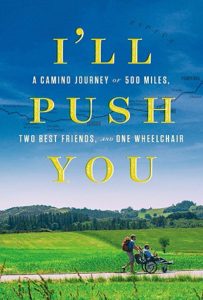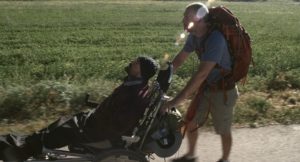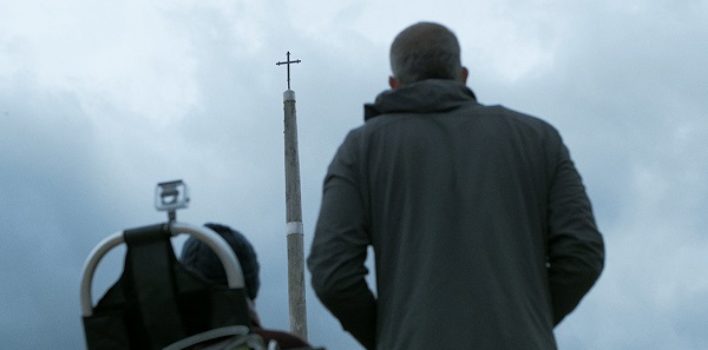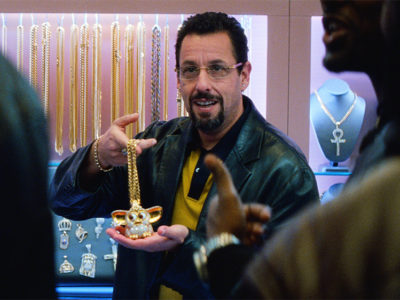Review| I’ll Push You
A month ago we featured Hunter Van Wagenen’s interview with the stars and a director of this film. Today, we’re happy to publish his review of I’ll Push You.
 Imagine hiking the Camino de Santiago, a 500-mile pilgrimage across Spain. Imagine crossing mountain ranges on rocky stone paths amid sheep and goats, and walking over shade-less tableland for days on end. Imagine walking in the footsteps of millions of pilgrims throughout twelve centuries, all of whom were seeking for a blessing. Imagine doing all that with your best friend pushing you in a wheelchair.
Imagine hiking the Camino de Santiago, a 500-mile pilgrimage across Spain. Imagine crossing mountain ranges on rocky stone paths amid sheep and goats, and walking over shade-less tableland for days on end. Imagine walking in the footsteps of millions of pilgrims throughout twelve centuries, all of whom were seeking for a blessing. Imagine doing all that with your best friend pushing you in a wheelchair.
I’ll Push You tells the story of two lifelong friends, Justin and Patrick, who did just that. After Justin was diagnosed with a rare disease that gradually reduced his mobility, ending his career and confining him to a wheelchair, he saw a TV special about the Camino and knew that he had to do it. His best friend Patrick immediately agreed to help, hence the title of the film.
I’ve seen a few films set on the Camino, and I feel like I hear about a new documentary every other year, but I was excited to see this one. For one thing, I have a professional interest since I’ve walked the Camino four times and my wife and I hope to start a ministry to pilgrims there. More importantly, this film promised to tell a story that would be profound without falling into any of the Hollywood contrivances of a fictional narrative.
The film is, first of all, incredibly inspiring. I’m talking Team Hoyt, show-a-clip-to-your-youth-group inspiring. It was amazing to watch Patrick and others push, pull, and at some points carry Justin up mountains, across rivers, up to 18 miles a day, and still feed him, dress him, clothe him, and move him at the end of the day’s hike. I could remember all my old blisters as I watched Patrick struggle up hills, wincing in pain.
 Justin and Patrick and the other pilgrims were surprisingly funny. Some of the humor in other films set on the Camino is probably pretty funny to someone who’s tired from a day of hiking, but usually fell flat for me as I watched it, but I found myself laughing out loud at some of Justin’s comments or at the banter between the pilgrims. Even in the midst of their fatigue, even in dealing with a lot of handicapped-unfriendly hotels and hostels, both of the guys use humor to build the other up.
Justin and Patrick and the other pilgrims were surprisingly funny. Some of the humor in other films set on the Camino is probably pretty funny to someone who’s tired from a day of hiking, but usually fell flat for me as I watched it, but I found myself laughing out loud at some of Justin’s comments or at the banter between the pilgrims. Even in the midst of their fatigue, even in dealing with a lot of handicapped-unfriendly hotels and hostels, both of the guys use humor to build the other up.
The pacing of the film is unique among Camino documentaries as well. It has a dual narrative structure that follows the guys on their trek across Spain, while also using interviews with their wives and other family members to gradually reveal more about them and their friendship. Over time the viewers get to appreciate the strengths and weaknesses of both these men, and understand how they complement one another.
I tend to watch films about the Camino like case studies for ministry – these are the types of people I hope to meet and share the Gospel with and minister among whenever I’m there – but because this film billed itself as “A Story of Friendship and Faith” I was especially interested. Just what kind of faith would be on display in this film? It wasn’t until I got to talk to Justin, Patrick, and one of the directors, Terry, that I appreciated how the film presents faith; at first I felt a bit let down at how little active praying and Jesus talk I saw, but Terry helped me see the film in a new light.
The directors made a strong effort not to hide Justin and Patrick’s Christian faith, but focused in on the actions of faith rather than the words. As the film progresses, viewers get to watch Justin trust time again, and also get to see Patrick’s faith grow over the course of the pilgrimage. The signs and symbols of faith appear throughout the film in montages of the setting, and the interviews from “those back home” build a narrative of both individual and family faith.
 Since most Camino films are about individual journeys or about some unique connection with a person on the trail (that, my cynicism usually assumes, won’t continue after they go home), my favorite part of the film was seeing the friendship between Justin and Patrick. These two were already friends going into it, had their friendship deepened by their experience, and continue to be friends after the fact. It was refreshing in our over-sexualized culture to see two guys who grew up together, who hug and wrestle and kiss each other, without a single hint of either homophobia or erotic attraction. They care for each other, encourage each other, and are involved in each other’s families.
Since most Camino films are about individual journeys or about some unique connection with a person on the trail (that, my cynicism usually assumes, won’t continue after they go home), my favorite part of the film was seeing the friendship between Justin and Patrick. These two were already friends going into it, had their friendship deepened by their experience, and continue to be friends after the fact. It was refreshing in our over-sexualized culture to see two guys who grew up together, who hug and wrestle and kiss each other, without a single hint of either homophobia or erotic attraction. They care for each other, encourage each other, and are involved in each other’s families.
One more message I would be remiss not to discuss is the theme of community, particularly the importance of receiving actions of love and friendship. Over the course of the film, more and more fellow pilgrims become involved in Patrick and Justin’s journey, and these two friends have learn how to receive acts of service as well as giving them. This film shows in a powerful way that sometimes the most humble action a person can take is not to serve but to admit defeat or weakness and allow someone stronger to serve them.







